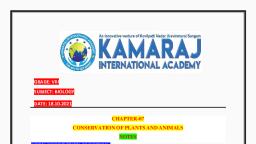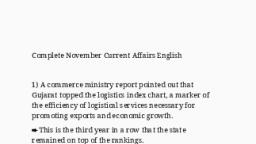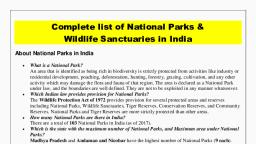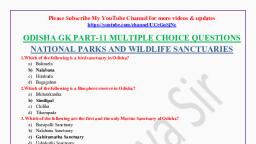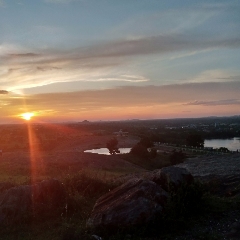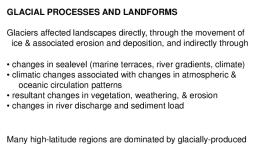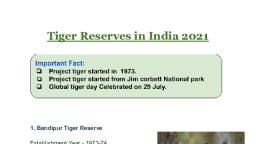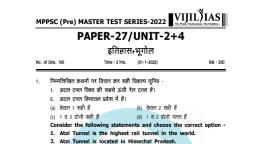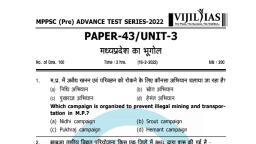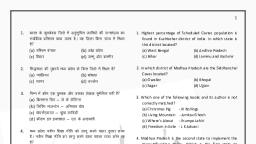Page 1 :
Environment & Ecology- January, 2022 Batch, Preliminary Exam Syllabus, ▪ General issues on Environmental, Ecology, Biodiversity and Climate, Change(that do not require subject, specialization.), ▪ Current Affairs (Related to Biodiversity,, conservation efforts, developments in the, field, etc.), , Mains Exam Syllabus, GS Paper 1, ▪ Geographical features and their location- changes, in critical geographical features (including water, bodies and ice-caps) and in flora and fauna and the, effects of such changes., GS Paper 3, ▪ Conservation, Environmental pollution and, Degradation, Environmental Impact Assessment, ▪ Disaster and Disaster management, , Sources & Books:, , 1. Environment & Ecology, , a. Ecology and Ecosystem- Concept, Meaning, Properties, b. Ecosystem and Its functioning- System’s Analysis Approach, (Only Basic needed to be mentioned in mains for extra marks), and Understanding, Source: NCERT 12th class Biology chapter 14, c. Types of Ecosystem, i. Terrestrial Ecosystem, ii. Aquatic Ecosystem, d. Environment Pollution: Types, Genesis and Their Impact, e. Contemporary Environmental Issues and Future Challenges, f. Environmental Impact assessment, Source- NCERT 12th class Biology Chapter 16, , 2. Biodiversity and, Conservation, , a. Biodiversity- Concept and Importance, b. Brief of Biodiversity in India: Extent of Endemism of, biodiversity in India, c. Legislations On biodiversity in India, d. Protected flora and Fauna- Glimpse of WPA1972, e. Animal Diversity in India and ZSI, f. Plant diversity in India and BSI, g. Marine Organism- Protected Global areas, Organization, and, Effort, h. Protected area Network, , (Batch-Jan, 2022) Sudarshan Gurjar’s Compiled Environment Handout → 1
Page 2 :
i. Conservation Efforts, j. Concept Of Sustainable Development, Sources● Chapter 15 - NCERT 12th class Biology, ● MoEF&CC website, ● PIB/The Hindu, 3. Climate Change, , a. Concepts, b. Impact of climate change- India, c. Ocean Acidification, d. Ozone Depletion, e. Mitigation Strategies, f. Climate Change vis-a-vis Developmental issues, g. India and Climate change- Legislation, h. Global Climate change-related Organizations and schemes, Sources● NIOS Environment Module 4 section Regular Current, Affairs from any authentic source, , 4. Biosphere: An Ecosystem, , a. Biosphere as an ecosystem, b. Trophic level and energy flow, c. Circulation of matter- Biogeochemical and sedimentary cycles, d. Hydrological cycle, e. Biogeographical Realms, Sources- NCERT 12th class Biology Chapter 14, , 5. Biomes, , a. Meaning and concept, b. Classification of Biomes and related socio-economic activities, Sources● Basic Study from Geography NCERTs, ● Certified Physical and Human Geography by Goh Cheng, Leong Part 2- Chapter 13 to 25, , 6 Sustainable Development Source: Visit United Nations Sustainable Development, 2015- 2030, Knowledge Platform https://sustainabledevelopment.un.org/, 7. Important Chapters of Source: Visit the Ministry of Finance’s following Website, Economic Survey Related to https://www.indiabudget.gov.in/economicsurvey/, Environment Source, , (Batch-Jan, 2022) Sudarshan Gurjar’s Compiled Environment Handout → 2
Page 3 :
8. The Economics and Source: Regular Current Affairs from any authentic source, Geopolitics of Environment, 9.Miscellaneous, , ● MoEFCC Website, ● All the reports related to Environment and their, publishing authority, ● Ecofeminism, ● Module 8A and 8B of NIOS, ● National Disaster Management Plan- NDMA and National, Policy on DM summary, , Notes of the 3rd ARC report 1. India’s Key Hazards, Vulnerabilities, on Crisis Management, 2. 12 Crisis Response Mechanism, 3. Recommendations, Magazines, 1. Only Yojana magazines released on environment issues, Table of Content, Protected Area Network, IUCN, IUCN and India, IUCN protected area categories:, IUCN Red List, IUCN criteria, IUCN Red list categories, Conservation Reserves and Community Reserve, Tillari Conservation Reserve, National Parks in India, Category II: National Park, Declaration of the Protected Area by the State government, Declared By the Central government, Project Tiger, National Tiger Conservation Authority(NTCA), Powers and functions of NTCA, Structure of a Tiger Reserve, Tiger Task Force, Tiger Census, Methods for Tiger Census, Tiger Census, 2014, Tiger Census, 2018, , 🐅, , 🧔, , 👨, , (Batch-Jan, 2022) Sudarshan Gurjar’s Compiled Environment Handout → 3, , 7, 7, 7, 7, 9, 9, 9, 10, 11, 11, 12, 12, 12, 12, 13, 13, 13, 14, 14, 14, 15, 15
Page 7 :
Kerala, Karnataka, Goa & Maharashtra, Gujarat, Importance of Mangroves, India State of Forest Report, 2019, India State of Forest Report, 2021, Mangroves for the Future (MFF), Conservation of Mangroves, , 63, 64, 64, 64, 64, 65, 65, 65, 66, , Protected Area Network, IUCN, , ➢ International Union for Conservation of Nature and Natural Resources., ➢ Established in 1948., ➢ It is involved in data gathering and analysis, research, field projects, advocacy, and education., ➢ It has a membership of over 1400 governmental and non-governmental organizations., ➢ IUCN has observer and consultative status at the United Nations, (and plays a role in the, implementation of several international conventions on nature conservation and biodiversity., ➢ It was involved in establishing the World Wide Fund for Nature and the World Conservation, Monitoring Centre., IUCN and India, ▪ India, a megadiverse country with only 2.4% of the world's land area, accounts for 7-8% of all, recorded species, including over 45,000 species of plants and 91,000 species of animals., ▪ India became a State Member of IUCN in 1969, IUCN protected area categories:, ▪ Category Ia – Strict Nature Reserve, ▪ Category Ib – Wilderness Area, ▪ Category II – National Park, ▪ Category III – Natural Monument or Feature, , (Batch-Jan, 2022) Sudarshan Gurjar’s Compiled Environment Handout → 7
Page 8 :
▪ Category IV – Habitat/Species Management Area, ▪ Category V – Protected Landscape/Seascape/Area, ▪ Category VI – Protected Area with sustainable use of natural resources, ● In India,there are four major categories of Protected areas. These protected areas are constituted, under the provisions of the Wildlife (Protection) Act, 1972. The four categories of protected areas, are:, 1.Wildlife Sanctuaries CAT 4, 2.NationalParks CAT 2, 3.CommunityReserves CAT 6, 4.Conservation Reserve CAT 5, ● Apart From these protected areas,India also has the following:, •BiodiversityReserves, •TigerReserves, •ElephantReserves, NOTE-BIOSPHERE RESERVE – CAT 5 -UNESCO, ● As of June 2021, there were 993 notified protected areas covering 5.59% of India’s land area., This is far below Target 11 of the Aichi Targets – which states that by 2020, at least 17% of, terrestrial and inland water areas should be conserved under Protected Areas., , (Batch-Jan, 2022) Sudarshan Gurjar’s Compiled Environment Handout → 8
Page 9 :
IUCN Red List, ● The IUCN Red List of Threatened Species (also known as the IUCN Red List or Red Data List), was founded in 1964., ● It has evolved to become the world’s most comprehensive information source on the global, conservation status of animal, fungi and plant species., ● A series of Regional Red Lists are produced by countries or organizations., IUCN criteria, ● The IUCN system uses a set of five quantitative criteria to assess the extinction risk of a given, species., ● In general, these criteria consider:, 1. The rate of population decline., 2. The geographic range., 3. Whether the species already possesses a small population size (mature individuals only)., 4. Whether the species population is very small or lives in a restricted area., 5. Whether the results of a quantitative analysis indicate a high probability of extinction in the, wild., IUCN Red list categories, ● Species are classified by the IUCN Red List into nine groups:, 1. Extinct (EX)– No known individuals remaining., 2. Extinct in the wild (EW)– Known only to survive in captivity, or as a naturalized population, outside its historic range., 3. Critically endangered (CR)– Extremely high risk of extinction in the wild; Population declinemore than 90% in the last 10, years or three generations., 4. Endangered (EN)– High risk, of extinction in the wild;, Population decline: >70% in the, , (Batch-Jan, 2022) Sudarshan Gurjar’s Compiled Environment Handout → 9
Page 10 :
last 10 years or three generations., 5. Vulnerable (VU)– High risk of endangerment in the wild; Population decline: >50% in the last, 10 years., 5. Near threatened (NT)– Likely to become endangered in the near future., 6. Least concern (LC)– Lowest risk (Does not qualify for a more at-risk category; widespread, and abundant taxa are included in this category.), 7. Data deficient (DD)– Not enough data to make an assessment of its risk of extinction., 8. Not evaluated (NE)– Has not yet been evaluated against the criteria, , 🔢? The “Red Data Books'' published by the International Union for Conservation of Nature and, Natural Resources (IUCN) contain list of: (UPSC CSE 2011), 1., , Endemic plant and animal species present in the biodiversity hotspots., , 2., , Threatened plant and animal species., , 3., , Protected sites for conservation of nature and natural resources in various countries., , Select the correct answer using the codes given below:, (a) 1 and 3 (b) 2 only (c) 2 and3 (d) 3only, Conservation Reserves and Community Reserve, ● Conservation Reserves and community reserves are terms denoting protected areas which, typically act as buffer zones too or connectors and migration corridors between established, national parks,wildlife sanctuaries, and reserved and protected forests ofIndia., ● Such areas are designated conservation areas if they are uninhabited, completely owned by the, Government of India but used for subsistence by communities, and community areas if part of the, lands are privately owned., ● These Protected Area categories were first introduced in the Wildlife (Protection) Amendment, Act of 2002− the amendment to theWildlife Protection Act of 1972., ● Amendments to the Wildlife protection act in 2003, provided a mechanism for, recognitionandlegalbacking to the community initiated efforts in wildlife protection., , (Batch-Jan, 2022) Sudarshan Gurjar’s Compiled Environment Handout → 10
Page 11 :
● It provides a flexible system to achieve wildlife conservation without compromising community, needs. These categories were added because of reduced protection and around existing or proposed, protected areas due to private ownership of land and land use., ● These categories roughly correspond to IUCN Category V (conservation reserves) and VI, (community reserves) protected areas., Tillari Conservation Reserve, ● The Maharashtra Government has declared 29.53 sq km area of Dodamarg forest range in, Sindhudurg district as‘Tillari Conservation Reserve’.(Jul 2020), •Tillari is the seventh wildlife corridor in the state to be declared as a ‘conservation reserve’, •The area covering nine villages in the forest range is known to serve as a corridor and even as a, habitat for the population of tigers and elephants moving between the three states of, Goa,Karnataka, and Maharashtra, •It connects the Mhadei sanctuary in Goa and Bhimgad Karnataka., •It has semi-evergreen forests,tropical moist deciduous forests, and a number of unique trees,, butterflies, and flowers., National Parks in India, • National park has more restrictions as compared to a wildlife sanctuary.Their, boundaries are fixed and defined., • Here, no human activity is allowed.They cannot be downgraded to the status of a, ‘sanctuary’.National parks can be declared both by the CentralGovernment and State, governments., • National parks in India are IUCN category II protected areas. India’s first national parkways, established in 1936 as Hailey National Park, now known as Jim Corbett National, Park,Uttarakhand., •The Chief Wildlife Warden shall be the authority who shall control, manage, and maintain all, protected areas., •No alteration of boundaries in national parks and wildlife sanctuaries can be done without the, approval of the NBWL., , (Batch-Jan, 2022) Sudarshan Gurjar’s Compiled Environment Handout → 11
Page 12 :
•National Board for Wildlife Wildlife Protection Act, 1972 . chaired by the Prime Minister 47, members including the Prime Minister. Among these, 19 members are ex-officio members., •Other members include three Members of Parliament (two from Lok Sabha and one from Rajya, Sabha), five NGOs, and 10 eminent ecologists, conservationists, and environmentalists., Category II: National Park, • Large natural or near natural areas set aside to protect large scale ecological processes, along with, the complement of species and ecosystems characteristic of the area, which also provide a, foundation for environmentally and culturally compatible spiritual, scientific, educational,, recreational and visitor opportunities., Declaration of the Protected Area by the State government, , 👨, , •Initial Notification: The State government may, by notification,declare its intention to constitute, any area within or outside any reserve forest as a sanctuary/national park ifit considers that such, area is of adequate ecological,faunal,floral, geomorphological, natural, or zoological, significance,for the purpose of protecting, propagating or developing wildlife or its environment., •Final Notification: After the initial notification has been issued and the period for preferring, claims has elapsed,the State government may issue a notification specifying the limits of the area, which can be comprised within the sanctuary and declare the said area shall be a sanctuary/national, park from such date as may be specified thenotification., Declared By the Central government, , 🧔, , •The CentralGovernment may declare an area to be a sanctuary/national park ifitis satisfied that the, area is of adequate ecological,faunal,floral, geomorphological, natural, or zoological, significance,for the purpose of protecting, propagating or developing wildlife or its environment., , 🐅Project Tiger, ● 🧔Centrally sponsored scheme launched in 1973., , ● The project aims at ensuring a viable population of tigers in their natural habitats and protecting, them from extinction.., ● Project Tiger is administered by the National Tiger Conservation Authority., , (Batch-Jan, 2022) Sudarshan Gurjar’s Compiled Environment Handout → 12
Page 13 :
National Tiger Conservation Authority(NTCA), ● Boss? Ministry of Environment & Forest, ● The Wild Life (Protection) Amendment Act, 2006 provided for creating the National Tiger, Conservation Authority., ● The National Tiger Conservation Authority (NTCA) is a statutory body., ● The Minister of State for Environment and Forests is the Vice-chairperson., Powers and functions of NTCA, ● Approval of Tiger Conservation Plan prepared by States, , 👨🦲., , ● Laying down normative standards for tiger conservation,, , ● Providing information on several aspects which include protection, tiger estimation, patrolling,, etc.,, ● Ensuring measures for addressing man-wild animal conflicts and fostering coexistence with local, people,, ● Preparing annual report for laying before Parliament,, ● Ensuring agricultural, livelihood interests of people living in and around Tiger Reserves., Structure of a Tiger Reserve, ● Tiger reserves which are governed by Project Tiger have two zones:, 1. Core zone:, ● Critical inviolate tiger habitat areas, ● It has the legal status of a national park or wildlife sanctuary, ● It is kept free of all biotic and human disturbances, 2. BufferZone:, ● Surrounds core zone., ● It aims at promoting coexistence between wildlife and human activity., ● The livelihood, developmental, social and cultural rights of the local people are recognised in, this zone., [Note: The alteration of boundaries or denotification of Tiger Reserves can be done by state, governments but only with the prior approval of NTCA and National Board for WildLife.], , (Batch-Jan, 2022) Sudarshan Gurjar’s Compiled Environment Handout → 13
Page 14 :
Tiger Task Force, •The implementation of Project Tiger over the years has highlighted the need for a statutory, authority with the legal backing to ensure tiger conservation., •ESTD- 2005, •On the basis of the recommendations of the National Board for Wild Life, a Task Force was set up, to look into the problems of tiger conservation in the country., •The recommendations of the Task Force include strengthening Project Tiger by giving it statutory, and administrative powers., Tiger Census, , ● Indian Tiger Census is conducted by NTCA in collaboration with the Wildlife Institute of India, (WII). (The Wildlife Institute of India (WII), an autonomous institution under the Ministry of, Environment Forest and Climate change, Government of India, was established in 1982.Dehradun), ● Conducted after every 4 years (2006, 2010, 2014 and 2018)., ● In the case of tigers, every individual tiger will have a unique stripe pattern— just like our, fingerprints. (Camera trapping method scans stripes), ● Where the camera trappings are unavailable because of logistical constraints, DNA extracts from, scat (poop) samples are collected for analysis. (July 29th- Global Tiger Day), ● 2021 Theme of Global Tiger Day: “Their survival is in our hand”, Methods for Tiger Census, 1. PugmarkTechnique:, ● Most popular technique, ● A tiger leaves a distinct pugmark on the ground, different from that of others in the big cat family., ● This is the cheapest technique and can assess the number, sex ratio and age (young or adult) of, large cats but it is not very reliable as its accuracy is not very good., 2. Camera trapping Method:, ● Heat and motion sensitive cameras with night vision facilities are installed in tiger areas and left, for several days to capture images of individual tigers., ● Accuracy is almost the same as the Pugmark method., , (Batch-Jan, 2022) Sudarshan Gurjar’s Compiled Environment Handout → 14
Page 15 :
● But it does not involve a labor survey done in the Pugmark method, therefore there is no local, employment generation., ● Also cameras cannot be installed at every place that is likely to have tigers., ● Also, there is no certainty that the tiger would walk into a camera range., ● Salty, hot and humid areas=> Damage to camera, ● Costlier method than Pugmark., 3.Poop/scat Method: Poop/scat (droppings of the tiger) is analyzed by DNA sampling to arrive at, a more accurate count., 4.Radio Collar Method: Tigers are captured and are fitted with a radio collar. (This method fails, when the concerned tiger enters the salty water), 5.Double-sampling Method: First count by Pugmark technique, then reconfirmation by Camera, trapping method;, Tiger Census, 2014, ● “Status of Tigers in India, 2014” report by NTCA Findings:, ● India is home to world’s 70% of the world's tigers., ● 30% increase from 2011; 2226 tigers in 2014 (1706 in 2010; 1411 tigers in 2006), ● Karnataka has the highest number of tigers., ● The tiger population has increased in Karnataka, Uttarakhand, Madhya Pradesh, Tamil Nadu and, Kerala., ● The Mudumalai-Bandipur-Nagarhole-Wayanad belt across Karnataka, Tamil Nadu and Kerala:, 570 tigers. (world’s single largest tiger population), ● Decline in population in states such as Odisha, Jharkhand and Andhra Pradesh due to poaching, and insurgency., Tiger Census, 2018, ● This is the first time neighbouring countries of Nepal, Bangladesh and Bhutan took part in the, census because they constitute a larger tiger range in the Indian subcontinent., ● This collaboration ensured that there is no double counting of tigers that move between national, borders and it will be possible to count how many are shared between the countries., ● Parks sharing borders:, , (Batch-Jan, 2022) Sudarshan Gurjar’s Compiled Environment Handout → 15
Page 16 :
1. Royal Manas National Park in Bhutan: Manas National Park in Assam., 2. Valmiki Tiger Reserve in Bihar: Chitwan National Park in Nepal., 3. Pilibhit Tiger Reserve in Uttar Pradesh: Shuklaphanta National Park in Nepal., Findings of tiger census, 2018 - ‘Status of Tigers in India –2018’:, ● There has been a 33 per cent jump in the number of tigers from 2014., ● The number of tigers increased from 2,226 in 2014 to 2,967 in 2018., ● Madhya Pradesh saw the highest number of tigers at 526, closely followed by Karnataka at 524, with Uttarakhand at number 3 with 442 tigers., ● India achieved its commitment to the St.Petersburg Declaration, of doubling Tiger population,, much in advance to the 2022 deadline., ● Chhattisgarh and Mizoram saw a decline in their tiger numbers while tiger’s numbers in Odisha, remained constant., ● India is home to 80 percent of tigers in the world. In 2006, there were 1,411 tigers which, increased to 1,706 in 2010, 2,226 in 2014 and 2967 in 2018., ●Increase in Tiger population: Madhya Pradesh (71%) > Maharashtra (64%) > Karnataka (29%)., • Madhya Pradesh's Pench Sanctuary and Kerala’s Periyar sanctuary emerged as the, best-managed tiger reserves in the country., • Sathyamangalam Tiger Reserve in Tamil Nadu registered the “maximum improvement” since, 2014., • The Dampa and Rajaji reserves in Mizoram and Uttarakhand respectively are at the bottom of the, list in terms of Tiger count., • No tiger has been found in the Buxa (West Bengal), Palamau (Jharkhand) and Dampa (Mizoram), reserves., •Corbett has highest number of 252-266 tigers in country, •Largest Tiger Reserve in India– Nagarjunsagar-Srisailam Tiger Reserve (Andhra Pradesh,, Telangana), •Smallest Tiger Reserve in India– Bor Tiger Reserve (Maharashtra), M-STrIPES, ● M-STrIPES = Monitoring System for Tigers-Intensive Protection and Ecological Status., , (Batch-Jan, 2022) Sudarshan Gurjar’s Compiled Environment Handout → 16
Page 17 :
● Android software for collecting, archiving and analyzing data., ● Forest guards in tiger reserves are equipped with personal digital assistants and GPS devices to, capture data relating to tiger sightings, deaths, wildlife crime and ecological observations while, patrolling., ● M-STrIPES maps the patrol routes of forest guards, and the resulting data are then analyzed in a, geographic information system., , 🔢The term ‘M-STRIPES’ is sometimes seen in the news in the context of (UPSC CSE 2017), (a) Captive breeding of Wild Fauna, (b) Maintenance of Tiger Reserves, (c) Indigenous Satellite Navigation System, (d) Security of National Highways, Protection Status:, , ⚾⚾🎓✋Indian Wildlife (Protection) Act, 1972: Schedule I International Union for, Conservation of Nature (IUCN) Red List: Endangered., ⚾⚾🎓✋Convention on International Trade in Endangered Species of Wild Fauna and, Flora (CITES): Appendix I., Global Tiger Forum, • Global Tiger Forum is an Inter-Governmental international body working exclusively for the, conservation of Tigers., • Established in 1994, the Global Tiger Forum (GTF) has its headquarters in New Delhi., • The General Assembly of GTF meets after every three years., • It utilizes cooperative policies, common approaches, technical expertise, scientific modules, and, other appropriate programs., • The Global Tiger Forum was set up to promote a worldwide campaign to save the tiger, its prey,, and its habitat., • The Global Tiger Forum has plans to promote a legal framework in the countries involved for, biodiversity conservation and to increase the protected area network of habitats of the tiger and, facilitate their inter passages in the range countries., , (Batch-Jan, 2022) Sudarshan Gurjar’s Compiled Environment Handout → 17
Page 18 :
• It is the only Inter-Governmental body to save the tiger worldwide., • 14 tiger range countries are its members. The UK , which is not a Tiger Range Country, recently, joined the GTF., Global Tiger Initiative (GTI), •The Global Tiger Initiative (GTI) was launched in 2008 as a global alliance of governments,, international organizations, civil society, conservation, and scientific communities, and the private, sector, with the aim of working together to save wild tigers from extinction., •The GTI’s founding partners included the World Bank, the Global Environment Facility (GEF), the, Smithsonian Institution, the Save the Tiger Fund, and International Tiger Coalition (representing, more than 40 non-government organizations). The initiative is led by the 13 tiger range countries, (TRCs)., Global Tiger Recovery Program (GTRP), ● Tigers are scattered among 13 Asian Tiger Range Countries (TRCs): Bangladesh, Bhutan,, Cambodia, China, India, Indonesia, Laos, Malaysia, Myanmar, Nepal, Russian Federation,, Thailand, andVietnam., ● To solve the tiger crisis, which represents the larger Asian biodiversity crisis, the TRCs,, international organizations, and civil society came together on a collaborative platform within the, framework of the Global Tiger Initiative (GTI) at St. Petersburg,Russia, ● After a two-year process of sharing knowledge and best practices and developing a common, vision, a GTRP was developed, with the shared goal of doubling the number of wild tigers globally, by 2022., Conservation Assured Tiger Standard Accreditation (CATS), ● Launched in 2013, implemented across 125 sites including India’s 94 sites., ● It is a globally accepted tool for conservation of tigers & sets best practices and standards to, manage tigers and assessments to benchmark progress., ● Global Tiger Forum & WWF are implementing partners of NTCA for CATS., ● 14 TR:- Manas, Orang, Kaziranga, Satpura, Panna, Kanha, Pench, Anamalai, Mudumalai,, Parambikulam, Sunderban, Valmiki, Dudwa, Bandipur., , (Batch-Jan, 2022) Sudarshan Gurjar’s Compiled Environment Handout → 18
Page 20 :
Ladakh, ❏, , Hemis National Park is a high altitude national park in the eastern Ladakh Union Territory, , of the Republic of India. Globally famous for its snow leopards., ❏, , The park is bounded on the north by the banks of the Indus River, and includes the, , catchments of Markha river., Himachal Pradesh, Inderkilla NP, Khirganga NP, Pin valley NP, Great Himalayan NP, Simbalbara NP, ❏, , Great Himalayan NP, is one of India's national parks, is located in Kullu region in the state, , of Himachal Pradesh. Tirthan flows through Great Himalayan National Park in H.P. (Himalayan, Tahr-NT; Himalayan Brown bear-CR), ❏, , Simbalbara NP is a national park in India, located in the Paonta Valley of Sirmour, , District, Himachal Pradesh, along its border with Haryana. The vegetation consists of dense Sal, forests., ❏, , Pin Valley NP is a National park of India located within the Lahaul and Spiti district, in the, , state of Himachal Pradesh, in far northern India. within the Cold Desert Biosphere Reserve., Uttarakhand, Govind Pashu Vihar NP, Gangotri NP, Valley of Flower NP, Nanda Devi NP, , 🐅, 🐅, , Rajaji NP, , Corbett NP, ❏, , Rajaji NP ➡three wildlife sanctuaries in the area namely, Chilla, Motichur and Rajaji, , sanctuaries were merged into one. three districts of Uttarakhand: Haridwar, Dehradun and Pauri, , (Batch-Jan, 2022) Sudarshan Gurjar’s Compiled Environment Handout → 20
Page 22 :
Desert NP, , 🐅, 🐅, , Ranthambore NP, , Mukundra hills NP, ❏, , @Darrah NP, , Desert NP➡Great Indian Bustard- CR – Rajasthan, Gujarat, Pakistan, Heaviest of the, , flying bird (State bird of Rajasthan), ❏, , Ranthambhore was established as the Sawai Madhopur Sanctuary in 1955 by the, , Government of India and was declared one of the Project Tiger reserves in 1973. known for its, Bengal tigers. Other fauna include the Indian leopard, nilgai, wild boar, sambar, striped hyena,, sloth bear,, ❏, , Sariska NP ➡Alwar district, Rajasthan, Apart from the Bengal tiger, the reserve includes, , many wildlife species including Indian leopard, jungle cat., ❏, , Keoladeo NP or Keoladeo Ghana National Park formerly known as the Bharatpur Bird, , Sanctuary in Bharatpur, Rajasthan. (siberian Crane-CR; Great Spotted Eagle-VU; Sarus, Crane-VU), ⇒Feb,2021- Bansi Paharpur sandstone-Pink coloured, high in demand. Illegal mining since, 2016 has Damaged area. So, the Rajasthan state government shifted the boundary of Bharatpur's, Bandh Baretha wildlife sanctuary to make room for mining. These stones are also to be used for, Ram Mandir, Ayodhya., ⇒Oct,2020- A month and half long special drive to uproot the invasive lantana bushes in the, famous Sajjangarh wildlife sanctuary in Rajasthan’s Udaipur district has helped in ecological, restoration of grasslands and saved biodiversity. The sanctuary is famous for Long-billed vulture,, commonly known as the Indian vulture (Critically Endangered)., , 🔢Which of the following are the tiger reserve?, 1., , Nanda Devi NP, , 2., , Rajaji NP, , 3., , Keoladeo NP, , 4., , Darrah NP, , 5., , Sariska NP, , (a), , 1&2, , (b) 1,3 & 5, , (c) 2,4 & 5, , (d) 1,2,3 & 5, , 🔢With reference to India’s Desert National Park, which of the following statements are correct?, (Batch-Jan, 2022) Sudarshan Gurjar’s Compiled Environment Handout → 22
Page 23 :
1.It is spread over two districts., Keoladeo NP, 2.There is no human habitation inside the Park., 3.It is one of the natural habitats of the Great Indian Bustard., Select the correct answer using the code given below; UPSC CSE 2017, 1.1 and 2 only, , 2.2 und 3 only, , 3.1 and 3 only, , 4.1, 2 and 3, , Bihar, Valmiki NP, Tiger Reserve and Wildlife Sanctuary is located at the India-Nepal border in the West, Champaran district of Bihar, India on the bank of river Gandak. The Harsha – Masan River system, originates from the Valmiki Forests and forms Burhi Gandak River down south. River Pandai, flows into Bihar (India) from Nepal in the eastern end of the Sanctuary and meets Masan. ( Bengal, tiger-EN,Indian rhinoceros-VU), ⇒ Union minister of state for environment, forests, and climate change Ashwini Kumar Choubey, on Thursday said the second, , 🐅, , reserve in Bihar would be set up in Kaimur. ·, , The state forest, , department had first spotted a tiger through camera traps in the Kaimur wildlife sanctuary on, March 26, 2020., , Assam, Raimona NP, Manas NP,Orang NP, Nameri NP, Kaziranga NP, Dibru-Saikhowa NP, Dihing, Patkai NP, ❏, , Raimona NP is bounded on the west by the Sankosh river and the Saralbhanga river on the, , east. Both the rivers are tributaries of Brahmaputra. The Pekua river defines Raimona’s southern, boundary. It is famous for Golden Langur(IUCN-EN), an endemic species which has been named, as the mascot of Bodoland region., ❏, , Bura Chapori Wildlife Sanctuary: Recently, Rhinoceros translocation study was carried, , out in the sanctuary. Brahmaputra River flows through the sanctuary, Sonitpur district of Assam., An ideal habitat for the Bengal florican (IUCN, Critically Endangered). Important fauna here, includes Indian-one horned rhinoceros, Asiatic water buffalo and Bengal tiger. It forms an integral, , (Batch-Jan, 2022) Sudarshan Gurjar’s Compiled Environment Handout → 23
Page 24 :
part of the Laokhowa-Burachapori ecosystem and is a notified buffer of the Kaziranga Tiger, reserve., ❏, , Manas NP (Bengal florican-CR; Assam roofed turtle-EN; Hispid hare-EN; Gee’s, , Golden Langur-EN; Pygmy Hog-CR; ⇒ Mar,2021-Recently Himalayan Serow(VU) seen in, this region., ❏, , Kaziranga NP which hosts two-thirds of the world's great one-horned, , rhinoceroses-VU,The park area is circumscribed by the Brahmaputra River, which forms the, northern and eastern boundaries, and the Mora Diphlu, which forms the southern boundary. Other, notable rivers within the park are the Diphlu (Wild Water Buffalo-EN; Barasingha(swamp, deer)-VU), ❏, , Orang NP→ It has a rich flora and fauna, including great Indian rhinoceros, pygmy hog,, , Asian elephant, wild water buffalo and Bengal tiger. Pachanoi river, Belsiri river and Dhansiri, River border the park and join the Brahmaputra river., ❏, , Dihing Patkai NP Dibrugarh and Tinsukia districts. Dehing is the name of the river that, , flows through this forest and Patkai is the hill. Recently Assam govt notified it as 7th National, park of the state under World Life Protection Act, 1972 section 35. The Dehing Patkai Wildlife, Sanctuary is also known as the Jeypore Rainforest. White winged Wood duck-EN, ❏, , Nameri NP - Elephant, ❏ Nameri National Park is a national park in the foothills of the eastern Himalayas in the, Sonitpur District of Assam, India. Nameri shares its northern boundary with the Pakhui, Wildlife Sanctuary of Arunachal Pradesh, The main Rivers are Jia- Bhoroli and Bor, Dikorai. Other tributaries of these two rivers are: Diji, Dinai, Nameri, Khari, Upper Dikiri, ❏ Dibru Saikhowa NP is a national park in Assam, India, located in Dibrugarh and, Tinsukia districts. The park is bounded by the Brahmaputra and Lohit Rivers in the north, and Dibru river in the south. Species include Bengal tiger, Indian leopard, clouded, leopard, jungle cat, sloth bear., , ⇒ Assam now has the third most National Parks after the 12 in Madhya Pradesh and nine, in the Andaman and Nicobar Islands., , (Batch-Jan, 2022) Sudarshan Gurjar’s Compiled Environment Handout → 24
Page 27 :
❏, , Phawngpui NP provides habitat for a range of birds including the rare Blyth's, , tragopan-VU, Mrs. Hume's pheasant-NT, which is the Mizoram state bird., Tripura, Clouded leopard NP, Rajbari NP, ❏, , Rajbari NP is a national park in the Trishna Wildlife Sanctuary, Tripura, India. (Trishna, , WLS), , 🔢Consider the following pairs (UPSC CSE 2014), 1. Dampa Tiger Reserve : Mizoram, , 2. Gumti Wildlife Sanctuary : Sikkim, 3. Saramati Peak : Nagaland, Which of the above pairs is /are correctly matched?, A. 1 only, , B. 2 and 3only, , C. 1 and 3only, , D. 1, 2 and 3, , ⇒ Malayan Giant Squirrel found in parts of NE, could vanish post-2050 due to Jhum poaching., says Zoological Survey of India. "Near-Threatened" in the IUCN list., Sikkim, Kangchenjunga NP→ Asian Wild Dog-EN, West Bengal, , 🐅, , Singalila NP, Neora valley NP, Gorumara NP, Jaldapara NP, Buxa NP(, Sunderban, ❏, , 🐅, , Reserve, , ), , Jaldapara NP→ Torsa river, joins kaljani and meets Brahmaputra→ Chilapata Forests is an, , elephant corridor → The park holds the largest rhino population in India after Kaziranga National, Park in Assam, ❏, , Neora Valley NP is situated in the Kalimpong district, West Bengal→ Neora River→ It is, , the land of the elegant red panda., ❏, , Buxa NP→ Raidak and Jayanti river, tributaries of brahmaputra→Indian leopard, Bengal, , tiger, clouded leopard, giant squirrel., , (Batch-Jan, 2022) Sudarshan Gurjar’s Compiled Environment Handout → 27
Page 28 :
❏, , Gorumara NP→ The park is located on the floodplains of the Murti River The major river, , of the park is the Jaldhaka river, a tributary of the Brahmaputra river system. The park is rich in, large herbivores including Indian rhinoceros, gaur, Asian elephant, sloth bear, chital, and sambar, deer., ❏, , Singalila NP→ River Rammam and River Sirikhola flow through the park., , 🔢Consider the following areas: (UPSC CSE 2012), 1. Bandipur, , 2. Bhitarkanika, 3. Manas, 4. Sundarbans, Which of the above are Tiger Reserves?, (a) 1 and 2only (b) 1, 3 and 4only (c) 2, 3 and 4only (d) l, 2, 3 and 4, Jharkhand, Betla National Park is a national park located on the Chota Nagpur Plateau in the Palamu district, of Jharkhand, India., Gujarat, Marine NP, Gir NP, Blackbuck NP, Vansda NP, ❏, , Gir National Park and Wildlife Sanctuary, also known as Sasan Gir.Shetrunji River→ The, , four reservoirs of the area are at four dams, one each on Hiran, Machhundri, Raval and Shingoda, rivers, including the biggest reservoir in the area, the Kamleshwar Dam, dubbed 'the lifeline of, Gir’.(Asian lion-EN), ❏, , Blackbuck National Park at Velavadar is situated in the Bhavnagar District of Gujarat state,, , India. (Macqueen Bustard-VU), ❏, , Vansda NP → Ambika River, , ❏, , Marine NP in the Gulf of Kutch is situated on the southern shore of the Gulf of Kutch,, , There are 42 islands on the Jamnagar coast in the Marine National Park, most of them surrounded, by reefs. The best known island is Pirotan Island., , (Batch-Jan, 2022) Sudarshan Gurjar’s Compiled Environment Handout → 28
Page 29 :
⇒ Recently Naliya Great Indian Bustard sanctuary in Kutch, Gujarat is in News as forest, Fire is there., , 🔢A sandy and saline area is the natural habitat of an Indian animal species. The animal has no, , predators in that area but its existence is threatened due to the destruction of its habitat. Which one, of the following could be that animal? (UPSC CSE-2011), (a) Indian wild buffalo, (b) Indian wildass, (c) Indian wild boar, (d) Indian Gazelle, , 🔢With reference to the wetlands of India, consider the following statements:, , 1. The country’s total geographical area under the category of wetlands is recorded more in, Gujarat as compared to other States., 2. In India, the total geographical area of coastal wetlands is larger than that of wetlands., Which of the statements given above is/are correct? (UPSC CSE 2012), (a) 1only (b) 2only (c) Both 1 and 2 (d) Neither 1 nor 2, Maharashtra, Sanjay Gandhi NP, Chandoli NP, Gugamal NP, Pench NP, Tadoba NP(, , 🐅, ❏, , reserve:- Melghat, nagzira, Sahyadri, Bor, , 🐅, , ), Navegaon NP, , Tadoba NP →Tadoba Andhari Tiger Reserve→ It is Maharashtra's oldest national park., , the Andhari River. the Moharli and Kolsa ranges. Indian leopards, sloth bears, gaur, nilgai,, ❏, , Gugamal NP is part of Melghat Tiger Reserve. The area is rich in wild mammals including, , Bengal tiger, Indian leopard, ❏, , Chandoli NP lies between the Radhanagiri and Koyna Wildlife Sanctuaries and forms the, , southern part of the Sahyadri Tiger Reserve. Warna river., ❏, , Pench NP → Pench River→ Satpura range. The Bengal tiger is the main cat species., , ⇒ 10 Apr, 2021- Navegaon-Nagzira Tiger Reserve, Maharashtra= Some miscreants started, a forest fire., , (Batch-Jan, 2022) Sudarshan Gurjar’s Compiled Environment Handout → 29
Page 33 :
Kalakad Mundanthurai TR, , 🐅, , ❏, , Mudumalai NP Indian vulture-CR; White-Rumped vulture-CR, , ❏, , Gulf of Mannar NP→ Thoothukudi & Dhanushkodi. (Dugong/Sea Cow-VU; Indo pacific, , bottlenose dolphin-NT), ❏, , Guindy NP→ Indian star tortoise-VU; Blackbuck, , ⇒ Feb,2021-Srivilliputhur-Meghamalai TR recently added. It is the 51st TR. near Meghamalai, Mountain. Meghamalai commonly known as the High Wavy Mountains, is a mountain range, located in the Western Ghats. The Megamalai Wildlife Sanctuary can be an excellent buffer to, the Periyar Tiger Reserve and Grizzled Squirrel Wildlife Sanctuary which can immensely, strengthen the conservation in the southern Western Ghats – the range of hills south of the, Palakkad Gap., , 🔢With reference to "dugong", a mammal found in India, which of the following statements, is/are correct?, , 1. It is a herbivorous marine animal., 2. It is found along the entire coast of India., 3. It is given legal protection under Schedule I of the Wildlife (Protection)Act, 1972., Select the correct answer using the codes given below. UPSC CSE 2015, (a) 1 and 2 (b) 2only (c) 1 and3 (d) 3 only, Telangana, Mrugavani NP, Mahavir Harina Vanasthali NP, Nagarjunsagar Srisailam, , 🐅, 🐅, , Kawal TR, , 🐅, , Amravati TR, , Goa, Mollen NP, Bhagwan Mahavir Sanctuary, , (Batch-Jan, 2022) Sudarshan Gurjar’s Compiled Environment Handout → 33
Page 35 :
(d) Deepor Beel, Andaman & Nicobar, Saddle peak NP, North button NP, Middle button NP, South button NP, Rani Jhansi Marine NP, Mt. Harriet NP, Mahatma Gandhi MAine NP, Campbell NP, Galathea NP, , Biosphere Reserves, Introduction, • Biosphere Reserves are large areas of biodiversity where flora and fauna are protected., • These regions of environmental protection roughly correspond to IUCN Category V Protected, areas., • The Indian government has established 18 Biosphere Reserves of India, which protect larger, areas of natural habitat (than a National Park or Wildlife Sanctuary)., , (Batch-Jan, 2022) Sudarshan Gurjar’s Compiled Environment Handout → 35
Page 36 :
• Biosphere Reserve (BR) is an international designation by UNESCO for representative parts of, natural and cultural landscapes extending over large area of terrestrial or coastal/marine, ecosystems or a combination thereof, • The Indian government has established 18 biosphere reserves in India., • 12 of the eighteen biosphere reserves are a part of the World Network of Biosphere Reserves,, based on the UNESCO Man and the Biosphere (MAB) Programme list., • Man and the Biosphere Programme (MAB) is an intergovernmental scientific programme., • launched in 1971 by UNESCO,, • aims to establish a scientific basis for the improvement of relationships between people and, their environments., Man And The Biosphere (MAB) Programme, ● Launched in 1971 by UNESCO., ● It provides a platform for cooperation on research and development, capacity building and, networking to share information, knowledge and experience on three interlinked issues:, ❏, , Biodiversity loss,, , ❏, , Climate change and, , ❏, , Sustainable development., , ● For implementation of its interdisciplinary work on the ground, MAB relies on the World, Network of Biosphere Reserves (WNBR)., There are currently 714 biosphere reserves in 129 countries, including 21 transboundary sites,, that belong to the World Network of Biosphere Reserves., Criteria For Designation Of BRs, ● A site that must contain an effectively protected and minimally disturbed core area of value of, nature conservation., ● The core area should be typical of a bio-geographical unit and large enough to sustain viable, populations representing all trophic levels in the ecosystem., ● Areas having rare and endangered species and indigenous varieties of biota., ● Areas having potential for preservation of traditional tribal or rural modes of living for, harmonious use of the environment., , (Batch-Jan, 2022) Sudarshan Gurjar’s Compiled Environment Handout → 36
Page 37 :
Functions Of Biosphere Reserves, ● Conservation of genetic resources, species, ecosystems and landscapes preserving the traditional, lifestyle and resources of the local people., ● Sustainable economic, cultural, social and ecological developments., ● Restoration of any damage caused to ecosystems and habitats., ● Generation of a lot of scientific information for specific scientific studies and research., ● Helps in sharing knowledge through site specific training and education., ● Development of community spirit in the management of natural resources., Structure and functions of BR, • Core Zone : Core zone must contain suitable habitat for numerous plant and animal species,, including higher order predators., • contain centers of endemism., • Core areas often conserve the wild relatives of economic species and also represent important, genetic reservoirs having exceptional scientific interest., • The core zone is to be kept free from human pressures, • Buffer Zone: These uses and activities include restoration, demonstration sites for enhancing, value addition to the resources, limited recreation, tourism, fishing, grazing, etc., • Research and educational activities are to be encouraged. Human activities, if natural within BR,, are likely to continue if these do not adversely affect the ecological diversity., • Transition Zone : The transition area is the outermost part of a biosphere reserve. • This is, usually not a delimited one and is a zone of cooperation where conservation knowledge and, management skills are applied and uses are managed in harmony with the purpose of the biosphere, reserve., • This includes settlements, crop lands, managed forests and areas for intensive recreation and, other economic uses characteristics of the region., , (Batch-Jan, 2022) Sudarshan Gurjar’s Compiled Environment Handout → 37
Page 38 :
The level of restriction in the increasing order is Biosphere Reserves, Wildlife Sanctuaries and, National Parks., Criteria for World Network of Biosphere Reserves, •It should encompass a mosaic of ecological systems representative of major bio geographical, regions, including a graduation of human interventions, •It should be of significance for biological diversity conservation, •It should provide an opportunity to explore and demonstrate approaches to sustainable, development on a regional scale, •It should have an appropriate size to fulfill the three functions of biosphere reserves, (conservation, development, logistic support), •It should include these functions through appropriate zonation, recognizing core, buffer, and outer, transition zones., , (Batch-Jan, 2022) Sudarshan Gurjar’s Compiled Environment Handout → 38
Page 40 :
• It has the largest population of two endangered species- lion-tailed macaque and nilgiri tahr., • About 80% of flowering plants reported from Western Ghats occur in Nilgiri Biosphere, Reserve., , 🔢Which of the following protected areas are under nilgiri BR?, 1., , Karimpuzha, , 2., , Agasthyamalai, , 3., , Kalakkad, , 4., , Meghamalai, , 5., , Periyar, , Select the correct option:, (a), , 1 only, , (b) 1,2 & 3, , (a), , Nilgiri, , (b) Nanda Devi, , (c) 2,3 &5, , (d) 1,2,3 & 5, , 🔢Which BR has two endangered species and 80% flowering plant reported?, © Manas, , (d) Meghamalai, , Nanda Devi BR, Nanda Devi and Valley of Flowers National Parks, Gulf of Mannar BR, • in the Coromandel Coast region., • The chain of low islands and reefs known as Ramsethu, also called Adam's Bridge, which, includes Mannar Island, separates the Gulf of Mannar from Palk Bay, which lies to the north, between Sri Lanka and India., • The Malwathu Oya (Malvathu River) of Sri Lanka and the estuaries of Thamirabarani River, and Vaipar River of South India drain into the Gulf., • The dugong (sea cow) is found here., Pachmarhi BR, • Bori Sanctuary (518.00 km2), • Pachmarhi Sanctuary (461.37 km2)., • Satpura National Park (524.37 km2), , (Batch-Jan, 2022) Sudarshan Gurjar’s Compiled Environment Handout → 40
Page 42 :
??? Consider the following pairs: [2013], 1. Nokrek Biosphere Reserve: Garo Hills, 2. Logtak (Loktak) Lake: Barail Range, 3. Namdapha National Park: Dafla Hills, Which of the above pairs is/are correctly matched?, (a) 1 only (b) 2 and 3 only (c) 1, 2 and 3 (d) None, Biodiversity Hotspots, ● A biodiversity hotspot is a biogeographic region which has high biodiversity but that is under, threat from destruction mainly due to human activities., ● The concept of biodiversity hotspot was given by Norman Myers in 1988 in his two articles in, “The Environmentalist”., ● Myers listed two criteria for a region to qualify as a biodiversity hotspot: a. It must have at least, 1,500 vascular plants as endemics— which is to say, it must have, ➔, , a high percentage of plant life found nowhere else on the planet. A hotspot, in other words,, , is irreplaceable., ➔, , It must have 30% or less of its original natural vegetation. In other words, it must be, , threatened., ● Myers originally recognised 25 hotspots but now 36 sites around the world follow his criteria., ● Conservation International has concluded the importance of biodiversity hotspots as- “Around, the world, 36 areas qualify as hotspots. They represent just 2.4% of Earth’s land surface, but they, support more than half of the world’s plant species as endemics — i.e., species found no place, else — and nearly 43% of bird, mammal, reptile and amphibian species as endemics.”, , 🔠? Three of the following criteria have contributed to the recognition of Western Ghats, Sri, Lanka and Indo Burma regions as hotspots of biodiversity: [2011], 1. Species richness, 2. Vegetation density, 3. Endemism, 4. Ethno-botanical importance, 5. Threat perception, , (Batch-Jan, 2022) Sudarshan Gurjar’s Compiled Environment Handout → 42
Page 43 :
6. Adaptation of flora and fauna to warm and humid conditions, Which three of the above are correct criteria in this context?, (a) 1, 2 and 6 only (b) 2, 4 and 6 only (c) 1, 3 and 5 only (d) 3, 4 and 6 only, Hottest Hotspots:, ● Hottest hotspots are the areas which have much more endemism and richness in biodiversity, than other hotspots., ● There are five factors considered for designating a hotspot as hottest hotspot:, 1., , Endemic plants,, , 2., , Endemic vertebrates,, , 3., , Endemic plants/area ratio, , 4., , Endemic vertebrates/area ratio and, , 5., , Remaining primary vegetation as % of original extent., , Eight hottest hotspots:, 1. Madagascar, 2. Philippines, 3. Sundaland, 4. Brazil’s AtlanticForest, 5. Caribbean, 6. Indo-Burma, 7. Western Ghats and Sri Lanka, 8. Eastern Arc and Coastal Forests ofTanzania/Kenya, Biodiversity Hotspots In India, 1.Himalaya: Includes the entire Indian Himalayan region (and that falling in Pakistan, Tibet,, Nepal, Bhutan, China and Myanmar), 2.Indo-Burma: Includes entire North-eastern India, except Assam and Andaman group of Islands, (and Myanmar, Thailand, Vietnam, Laos, Cambodia and southern China), , (Batch-Jan, 2022) Sudarshan Gurjar’s Compiled Environment Handout → 43
Page 44 :
3.Sundalands: Includes Nicobar group of Islands (and Indonesia, Malaysia, Singapore, Brunei,, Philippines), 4.Western Ghats and Sri Lanka: Includes entire Western Ghats (and Sri Lanka), , Mura-Drava Danube:, ● World’s First ‘Five-Country Biosphere Reserve’, ● Context: Recently, Mura Drava-Danube (MDD) was declared as the world’s first, ‘five-country biosphere reserve’ by the United Nations Educational, Scientific and, Cultural Organization (UNESCO)., ● About MDD: The biosphere reserve covers 700 kilometers of the Mura, Drava and, Danube rivers and stretches across Austria, Slovenia, Croatia, Hungary and Serbia., , Wetland, Introduction, • A wetland is a place where the land is covered by water. Marshes, ponds, the edge of a, lake/ocean, the delta at the mouth of a river, low-lying areas that frequently flood — all of these, are wetlands., , (Batch-Jan, 2022) Sudarshan Gurjar’s Compiled Environment Handout → 44
Page 45 :
• Wetlands are also considered the most, biologically diverse of all ecosystems,, serving as home to a wide range of plant and, animal life., National Wetland Conservation, Programme (NWCP), • The Government of India operationalized, the National Wetland Conservation Programme (NWCP) in close collaboration with the concerned, State Government during the year 1985/86., • Under the programme 115 wetlands have been identified till now by the Ministry which requires, urgent conservation and management initiatives., • The main wetland types are swamp, marsh, bog, and fen., • subtypes include mangrove forest, carr, floodplains,sink, and many others., • Many peatlands are wetlands., ➔, , A swamp is a wetland that is forested. Swamps are considered to be transition zones, , because both land and water play a role in creating this environment., ➔, , A marsh is a wetland that is dominated by herbaceous rather than woody plant species., , Marshes can often be found at the edges of lakes and streams, where they form a transition, between the aquatic and terrestrial ecosystems. They are often dominated by grasses, rushes, ➔, , A bog or bogland is a wetland that accumulates peat, a deposit of dead plant material., , ➔, , Fen: Peat rich areas that receive nutrients from the water that flows through them (surface, , runoff, groundwater). Typically flooded in the winter and dominated by mosses, sedges, rushes,, and shrubs. Streams and/or pools may be present., ➔, , If woody plants are present they tend to be low-growing shrubs, and then sometimes called, , carrs. Carrs are wetlands that are dominated by shrubs rather than trees., Uses of wetlands, • Water storage (flood control), , (Batch-Jan, 2022) Sudarshan Gurjar’s Compiled Environment Handout → 45
Page 46 :
• Groundwater replenishment, • Shoreline stabilization and storm protection, • Water purification, • Reservoirs of biodiversity, • Pollination, • Wetland products, • Cultural values, • Recreation and tourism, • Climate change mitigation and adaptation, Ramsar Convention, • The Ramsar Convention on Wetlands of International Importance is an international treaty for, the conservation and sustainable use of wetlands., • It is named after the city of Ramsar in Iran, where the Convention was signed in 1971., • Every three years, representatives of the Contracting Parties meet at the Conference of the, Contracting Parties (COP)., • COP12 was held in Punta del Este, Uruguay, in 2015., • COP13 was held in Dubai, United Arab Emirates, in October 2018., • China will host the next Ramsar COP14 in 2021., • The 2nd of February each year is World Wetlands Day, • There are over 2,300 Ramsar Sites on the territories of 171 Ramsar Contracting Parties across, the world., • The countries with the most Sites are the United Kingdom with 175 and Mexico with 142., • Bolivia has the largest area under Ramsar protection., International organization partners, • The Ramsar Convention works closely with six other organizations known as International, Organization Partners (IOPs). These are:, • Birdlife International, • International Union for Conservation of Nature (IUCN), • International Water Management Institute (IWMI), , (Batch-Jan, 2022) Sudarshan Gurjar’s Compiled Environment Handout → 46
Page 47 :
• Wetlands International, • WWF International, • Wildfowl & Wetlands Trust (WWT), • Other Partners, • Convention on Biological Diversity (CBD), • Convention to Combat Desertification (UNCCD),, • Convention on the Conservation of MigratorySpecies of Wild Animals, • Convention on MigratorySpecies (CMS),, • World Heritage Convention (WHC) and, • Convention on International Trade in Endangered Species (CITES)., • Project funding is done by various groups like multilateral development banks, bilateral donors,, UN agencies such as UNEP, UNDP,Non-governmental organizations etc., A wetland can be considered to be internationally important if any of the following criteria, apply, • "it contains a representative, rare, or unique example of a natural or near-natural wetland type, found within the appropriate biogeographic region.", • "it supports vulnerable, endangered, or critically endangered species or threatened ecological, communities.", • "It supports populations of plant and/or animal species important for maintaining the biological, diversity of a particular biogeographic region.", • "it supports plant and/or animal species at a critical stage in their life cycles, or provides refuge, during adverse conditions.", • "It regularly supports 20,000 or more waterbirds.", • "it is an important source of food for fishes, spawning ground, nursery and/or migration path on, which fish stocks, either within the wetland or elsewhere, depend., The Montreux Record (Use, , ⭐ symbol for Montreux record), , • The Montreux Record is a register of wetland sites on the List of Ramsar wetlands of, international importance where changes in ecological character have occurred, are occurring, or, , (Batch-Jan, 2022) Sudarshan Gurjar’s Compiled Environment Handout → 47
Page 48 :
are likely to occur as a result of technological developments, pollution or other human, interference., • It is a voluntary mechanism to highlight specific wetlands of international importance that are, facing immediate challenges., • It is maintained as part of the List of Ramsar wetlands of international importance, • The Montreux Record was established in 1990, Q. If a wetland of international importance is brought under the ‘Montreux Record’, what, does it imply? [2014], (a) Changes in ecological character have occurred, are occurring or are likely to occur in the, wetland as a result of human interference., (b) The country in which the wetland is located should enact a law to prohibit any human activity, within five kilometers from the edge of the wetland., (c) The survival of the wetland depends on the cultural practices and traditions of certain, communities living in its vicinity and therefore the cultural diversity therein should not be, destroyed., (d) It is given the status of ‘World Heritage Site’., Ramsar Sites in India, presently there are 49 ramsar sites in India., , (Batch-Jan, 2022) Sudarshan Gurjar’s Compiled Environment Handout → 48
Page 54 :
Which of the above pairs is/are correctly matched? (UPSC CSE 2012), A. 1 only, , B. 2 and 3only, , C. 1 and 3only, , D. 1, 2 and 3, , MAINS Question, GSM3-2018: What is a wetland? Explain the Ramsar concept of ‘wise use’ in the context of, wetland conservation. Cite two examples of Ramsar sites from India, , 🐘Project Elephant, Project Elephant, , • Project Elephant was launched in 1992., • It is a centrally sponsored scheme., • It is included in Schedule I of the Indian Wildlife (Protection) Act, 1972 and in Appendix I of the, Convention on, International Trade in Endangered Species of Flora and Fauna (CITES)., Objectives:, • to assist states having populations of wild elephants and to ensure long term survival of identified, viable populations of, elephants in their natural habitats, • addressing man-animal conflict., • Developing scientific and planned management measures for conservation of elephants., • Protecting the elephants from poachers, preventing illegal ivory trade and other unnatural causes, of death., Elephant Corridor, • An elephant corridor is defined as a stretch/narrow strip of forested (or otherwise) land that, connects larger, habitats with elephant populations and forms a conduit for animal movement between the habitats., , (Batch-Jan, 2022) Sudarshan Gurjar’s Compiled Environment Handout → 54
Page 55 :
• There are 101 identified corridors in India (published by the Wildlife Trust of India in, collaboration with Project Elephant and the U.K.based NGO Elephant Family, 2017), • Coal mining and iron ore mining are the two “single biggest threats” to elephant corridors in, central India., • Orissa, Jharkhand and Chhattisgarh, are mineral-rich states, but also have the highest number of, elephant corridors in the country, which makes them known for elephant-man conflicts., • Habitat loss leading to fragmentation and destruction caused by developmental activities., MIKE Programme, ● MIKE= Monitoring the Illegal Killing of Elephants., ● Established under CITES., ● CITES-MIKE prog. Started in South Asia in 2003., ● Monthly data collected from all sites and submitted to sub-regional office, ⇒ MIKE sites in India, • 1. Chirang Ripu (Assam ), • 2. Dihing Patkai (Assam), • 3. Eastern Dooars (WB), • 4. Deomali (Arunachal Pradesh), • 5. Garo Hills (Meghalaya), • 6. Mayurbhanj (Orissa), • 7. Mysore (Karnataka), • 8. Nilgiri (T N), • 9. Shivalik (Uttarakhand), • 10. Wayanad (Kerala), Haathi Mere Saathi Campaign, • MoEF&CC in partnership with the Wildlife Trust of India (WTI)., • Aims to improve conservation and welfare prospects of the elephant - India’s National Heritage, Animal., , (Batch-Jan, 2022) Sudarshan Gurjar’s Compiled Environment Handout → 55
Page 57 :
🐘UttarPradesh, Shivalik, , 🐘Karnataka, Bandipur; Mysore; Dandheli, , 🐘Kerala, Nilambar; Wayanad; Anamudi; Periyar, , 🐘TamilNadu, Nilgiri; Coimbatore; Annamalai; Srivilliputtur, , 🔢? With reference to Indian elephants, consider the following statements:, 1., , The leader of an elephant group is a female, , 2., , The maximum gestation period can be 22 months., , 3., , An elephant can normally go on calving till the age of 40 years only., , 4., , Among the States in India, the highest elephant population is in kerala., , Which of the statements given above is/ are correct? UPSC CSE 2018, 1.1 and 2 only, , 2.2 and 4 only, , 3.3 only, , 4.1,3 and 4 only, , Shivalik Elephant Reserve, -, , Nov,2020- The Government of India has asked the Uttarakhand government to consider, avoiding sensitive areas of the Shivalik Elephant Reserve while exploring land suitable, for use for the expansion of Dehradun’s Jolly Grant Airport., , -, , The area proposed for the expansion is a part of the Shivalik Elephant Reserve and it falls, within a 10-km radius of Rajaji National Park., , Nilgiri Elephant corridor, -, , Oct,2020- The Supreme court upheld a 2011 order of the madras high court on the Nilgiri, Elephant corridor, affirming the right of passage of the animals and the closure of, resorts in the area., , (Batch-Jan, 2022) Sudarshan Gurjar’s Compiled Environment Handout → 57
Page 58 :
-, , The supreme court’s order to seal and close 27 resorts operating in corridors used by, elephants in the Nilgiris is a necessary step to restore the ecology of the spaces., , -, , Weak regulation of ecotourism is severely impacting important habitats of elephants., , -, , It’s the state’s duty to protect “Keystone Species” like elephants, which are very much, important to the environment., , -, , Fragmentation of forests makes it all the more important to preserve migratory corridors., , -, , The movement of elephants is essential to ensure that their populations are genetically, viable, and help regenerate forests on which other species, including tigers, depend., , Mangrove, Introduction, • Mangroves represent a characteristic littoral तटीय (near the seashore) forest ecosystem., • These are mostly evergreen forests that grow in sheltered low lying coasts, estuaries, mudflats,, tidal creeks, backwaters (coastal waters held back on land), marshes and lagoons of tropical and, subtropical regions., • Mangroves are highly productive ecosystems, and the trees may vary in height from 8 to 20 m., They protect the shoreline from the effect of cyclones and tsunamis., • Since mangroves are located between the land and sea, they represent the best example of, ecotone., • Mangroves are salt tolerant trees, also called halophytes, and are adapted to harsh coastal, conditions., • They are adapted to the low oxygen (anoxic) conditions of waterlogged mud., • They produce pneumatophores (blind roots) to overcome the respiration problem in the anaerobic, soil conditions., • Mangroves grow below the high water level of spring tides., , (Batch-Jan, 2022) Sudarshan Gurjar’s Compiled Environment Handout → 58
Page 59 :
Red Mangrove (Rhizophora mangle), • Mangroves occur in a variety of configurations. Some species (e.g. Rhizophora) send arching, prop roots down into the water., , Stilt roots:, • While others (e.g. Avicennia) send vertical “Pneumatophores” or air roots up from the mud., , (Batch-Jan, 2022) Sudarshan Gurjar’s Compiled Environment Handout → 59
Page 60 :
• Stilt roots are adventitious roots that grow from lower stem nodes and join and become deeper in, the soil., • Prop root is an aerial root that develops from the horizontal branches of a tree., , Heritiera littoralis:, • Mangroves exhibit Viviparity mode of reproduction. i.e. seeds germinate in the tree itself (before, falling to the ground)., • The seed germinates and grows from its own resources while still attached to its parent., , (Batch-Jan, 2022) Sudarshan Gurjar’s Compiled Environment Handout → 60
Page 65 :
• They Provide numerous employment opportunities to local communities and augment their, livelihood., India State of Forest Report, 2019, • About 40% of the world's Mangrove Cover is found in South East Asia and South Asia ., • The mangrove cover in India is 4,975 sq km, which is 0.15% of the country’s total geographical, area., • Increase in the mangrove cover as compared to 2017 assessment: 54 sq km, • Among the states and UTs, West Bengal has the highest percentage of area under total Mangrove, cover followed by Gujarat and Andaman Nicobar Islands., • Top three states showing Mangrove cover increase: Gujarat > Maharashtra > Odisha, India State of Forest Report, 2021, •Total mangrove cover in the country is 4,992 sq km., •It also recorded an increase of 17 sq km in mangrove cover in the country as compared to the, previous assessment of 2019., •Top three states showing mangrove cover increase are Odisha (8 sq km) followed by, Maharashtra (4 sq km) and Karnataka (3 sq km)., , Mangroves for the Future (MFF), • Established in 2006, • Mangroves for the Future (MFF) is a unique partner-led initiative to promote investment in, coastal ecosystem conservation for sustainable development., • Co-chaired by IUCN and UNDP, MFF provides a platform for collaboration among the many, different agencies, sectors and countries which are addressing challenges to coastal ecosystems and, livelihood issues., • The goal is to promote an integrated ocean-wide approach to coastal management and to build, the resilience of ecosystem-dependent coastal communities., , (Batch-Jan, 2022) Sudarshan Gurjar’s Compiled Environment Handout → 65
Page 66 :
• Member countries: Bangladesh, Cambodia, India, Indonesia, Maldives, Myanmar, Pakistan,, Seychelles, Sri Lanka, Thailand, and Viet Nam, • Objectives: To achieve its goal of conservation, restoration and sustainable management of, coastal ecosystems as key natural infrastructure which support human well-being and security,, MFF implements actions guided by three main objectives., 1. Improve, share and apply knowledge to support the conservation, restoration and, sustainable use of coastal ecosystems., 2. Strengthen Integrated Coastal Management institutions and empower civil society, (including local communities) to engage in decision-making and management that, conserves, restores and sustainably uses coastal ecosystems., 3. Enhance coastal governance at all levels (regional, national, provincial, district and, community) to encourage integrated management programmes and investments that are, ecologically and socio-economically sound, and promote human well-being and security., Conservation of Mangroves, • UNESCO Designated Sites: The inclusion of mangroves in Biosphere Reserves, World Heritage, sites and UNESCO Global Geoparks contributes to improving the knowledge, management and, conservation of mangrove ecosystems throughout the world., • International Society for Mangrove Ecosystem (ISME): The ISME is a non-governmental, organization established in 1990 to promote the study of mangroves with the purpose of enhancing, their conservation, rational management and sustainable utilization., • Blue Carbon Initiative: The International Blue Carbon Initiative is focused on mitigating, climate change through the conservation and restoration of coastal and marine ecosystems., • It is coordinated by Conservation International (CI), IUCN, and the Intergovernmental, Oceanographic Commission UNESCO (IOC-UNESCO)., • International Day for the Conservation of the Mangrove Ecosystem: UNESCO celebrates, this day on July 26 with the aim of raising awareness about mangrove ecosystems and to promote, their sustainable management and conservation., , (Batch-Jan, 2022) Sudarshan Gurjar’s Compiled Environment Handout → 66
Page 67 :
• Mangroves for the Future Initiative: IUCN and UNDP developed a unique initiative to, promote investment in coastal ecosystem conservation called the “Mangroves for the Future, (MFF)”., • The member nations include Bangladesh, Cambodia, India, Indonesia, Maldives, Myanmar,, Pakistan, Seychelles, Sri Lanka, Thailand, and Vietnam., • National Mangrove Committee: The Government of India set up a National Mangrove, Committee in 1976 which advises the government about conservation and development of, mangroves., • There are some important mangrove species in India:, • Avicennia Officinalis, • Morinda Citrifolia, • Rhizophora mucronata, • Sonneratia Alba, • Avicennia Alba, • Bruguiera Cylindrica, • Heriteira Littoralis (Sundari tree), • Phoenix paludosa, • Ceriops Tagal, • West Bengal has 42.45 % of India’s mangrove cover (highest in the country.), • Mangroves make 1 % of the tropical forests of the world., • India has 3 % of the total mangrove cover in South Asia., , (Batch-Jan, 2022) Sudarshan Gurjar’s Compiled Environment Handout → 67
Page 68 :
Further Refer this:, ⇒https://www.downtoearth.org.in/blog/wildlife-biodiversity/scientificmanagement-of-mangrove, s-is-need-of-the-hour-64007, , (Batch-Jan, 2022) Sudarshan Gurjar’s Compiled Environment Handout → 68





